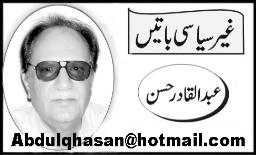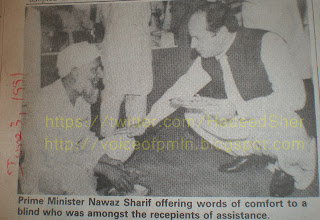کالم کار - ملک منظور احمد
This article was published in Daily The NEWS-Islamabad dated Feb. 20, 2013. The original article can be approached at the following link
http://www.thenews.com.pk/Todays-News-9-160979-The-unsung-hero-of-Kargil
-----------------------------------------------------------------------------------------------------------
The unsung hero of Kargil
Malik Zahoor Ahmad
Wednesday, February 20, 2013
From Print Edition
"Gentlemen! Thank you very much for gracing our Independence Day". That is how President Bill Clinton greeted Prime Minister Nawaz Sharif and his team at Blair House, the US Presidential Guest House, on July 4, 1999. Coming at the height of the Kargil crisis, the visit was critical. Just across the road from the White House, the almost 200 year-old Blair House has long been associated with events of monumental importance in world history.
The prime minister’s arrival in Washington was shrouded in mystery. The first reports of the visit came to the Pakistan Embassy not from our foreign office but the State Department. Everyone was caught unawares. Hurried meetings were called, confidential internal memos dug up, and briefs developed to be able to lay down all the necessary ground work for the emergency high-octane meeting. Nawaz Sharif arrived on July 3 at Andrews Airbase and was received by Prince Bandar Bin Sultan, the Saudi Ambassador to the US, and then taken for intense briefings.
It was evident at that time that Gen Musharraf’s unauthorised, illogical and non-strategic adventurism had pushed the situation to the precipice and a full-fledged war between two nuclear rivals was imminent. Musharraf’s claim that the prime minister had approved ‘Operation Badr’ (Kargil) is not true. The PM was briefed about the Kargil operation for the first time only around mid-May 1999 when a lot had already happened. Gen Majeed Malik, a military veteran and cabinet minister who attended the briefing, is reported to have strongly opposed the idea and bitterly criticised the operation calling it “silly and utterly illogical”.
By the time Nawaz Sharif touched down in Washington to defuse the situation, the entire world had descended on us in the Pakistan Embassy with Pakistan being criticised heavily, both in the print and the electronic media. In this backdrop, Nawaz Sharif battled his way up – pleading with the world to give diplomacy a chance.
The Americans are known for treating their holidays as sacrosanct and Independence Day is the veritable sanctum sanctorum. US functionaries were visibly ill at ease. Bringing President Clinton to the table to bail Pakistan out of the imbroglio on that day was not, therefore, business as usual. It was made possible in the face of the real and immediate danger of an all-out war. Saudi intervention on Nawaz Sharif’s SOS call made this possible. And the man who could work this miracle was Prince Bandar Bin Sultan.
Prince Bandar was the face of Saudi monarchy in Washington for 22 years, rubbing shoulders with five US presidents and ten secretaries of state. An inveterate networker, he was an ultimate Washington insider who could walk into the White House whenever he wished. His influence was so extensive that he was able to acquire AWACS surveillance aircraft for his country, despite bitter opposition from the Israeli lobby.
He staunchly supported the idea of forging close relations with Pakistan and China and believed that Pakistan was under-utilising its potential. He once asked former interim Prime Minister Moeen Qureshi: “I don’t understand why Pakistan is always afraid of Indian chicken”. He made China deliver intermediate range nuclear-warhead capable missiles despite strong opposition from CIA and the Department of State. During the Iran-Contra scandal, he bankrolled the whole affair. He pressured Col Qaddafi to deliver the suspects involved in the alleged bombing of PanAm Airline aircraft in 1988.
But the mother of all mysteries is how Mian Nawaz Sharif got hold of one of the most sought after men in the US at such a short notice. The strategy, nevertheless, worked and saved Pakistan and the region from war.
On July 4, 1999 the world media was sharply focused on what was going on inside the Blair House and keenly awaited gavel-to-gavel updates. No cameras were allowed inside the guest house; PTV and other media crew were forced to clear out. The prime minister – for obvious reasons – was interested in photo-ops with Clinton for political mileage. He asked me to ensure that the international media stayed on the scene despite the scorching heat.
Pakistani journalists Shaheen Sehbai and Mohammad Afzal Khan stood outside the guest house. I was more worried about the western media. Using my personal relationship with Andrea Koppel of CNN, I was able to persuade her to wait on one of the hottest days of the season.
The scene inside Blair House was intriguing, the pace painfully sluggish. The president’s aides including National Security Advisor Sandy Berger at one point sounded frustrated, unhappy to be in a firefight for an ally that apparently deserved no sympathy for being on the wrong side of global public opinion.
The US position was tough and arduous and its attending exasperation understandable. President Clinton seemed determined to help steer an erring ally out of harm’s way but also remained responsive to Indian outrage. Calming down the Indians was an uphill task. New Delhi was blowing hot and cold, the general public and the media were hysterically demanding a military response and the generals were impatiently waiting to teach Pakistan a lesson once and for all.
The Nawaz-Clinton talks went on late into the afternoon – down a bumpy path with a heavy traffic of faxes shuttling between Washington and New Delhi. The Indian acceptance of the ceasefire was an impossibility that came off under heavy pressure by President Clinton who had somehow developed a personal rapport with Nawaz Sharif.
Though apocryphal but the story goes that simplistic yet deeply sincere remarks by Nawaz Sharif for the US president in New York a couple of months earlier are said to have stayed with Clinton when he was going through the toughest patch in his political career in the midst of the Monica Lewinsky scandal. Being articulate about such situations is difficult but those who know Nawaz Sharif can testify that he comes across as an honest, down to earth and convincing negotiator. During the talks, these qualities worked in Pakistan’s favour.
Sharif never doubted a military take over. While the agreement was being documented, his anxiety was also mounting: “They will get me Mr President,” he whispered. Clinton quipped: “Yours is a rogue army. Keep them under civilian oversight”. Nawaz retorted: “It is not the army. It is (a) few dirty eggs. They will meddle to cover up the Kargil debacle”. And three months later, the military struck. The coup was inevitable. The ‘Dirty Four’ were afraid of a Kargil investigation and a possible court martial. Washington accepted it as a ‘fait accompli’.
After the October coup, those of us in the Embassy in Washington were in the dark knowing nothing about what was going on in Islamabad. There was intense media pressure - asking us to comment on what was happening back home. Ambassador Tariq Fatemi asked me to go to CNN without any brief and face the music, where I made an off-the-cuff comment: “Its not a coup, the president is still there, the constitution is intact, things are just being rearranged.” What else could I say?
Clinton always stood by Nawaz Sharif. On his few hours’ trip to Islamabad later, he refused to shake hands with Musharraf, and instead met President Tarar. But 9/11 changed the course and character of the history of the world, our region in particular.
Gen Musharraf had the last laugh. In order to stay in power he hacked everything – faked the referendum, rigged the elections, pushed us into a war we never deserved, destroyed district administrations, packed the superior judiciary with cronies and finally left behind an NRO-tainted accidental leadership. Nawaz Sharif arranged an honourable exit from Kargil but missed the gallows by inches. Gen Shahid Aziz deserves respect for telling the truth – which is always in short supply in our country. If we still have a few good men in the army, they just need to wake up and come out with the truth.
The writer is a former information minister at the Pakistan Embassy in Washington DC. Till recently he was chairman of the Pak-Afghan-US Trilateral Dialogue on Agriculture.
====================================================================























